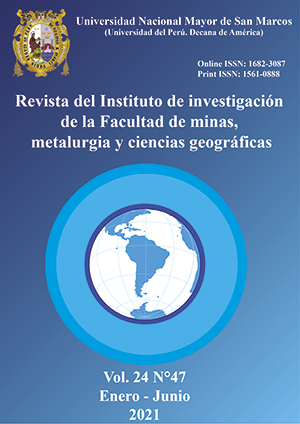Epithermal veins and their relationship with a possible IOCG type deposit in Cerro Colorado Chico, Ancash-Peru
DOI:
https://doi.org/10.15381/iigeo.v24i47.20660Keywords:
epithermal, IOCG, petromineralogy, geochemistry, statistic, fluid inclusionsAbstract
This article belongs to the project: "Study of the Mesozoic magmatism and its implications in the determination of a model of geological-structural exploration related to the occurrence of IOCG deposits in the Cordillera of the coast and pre-Andean plains of the Peruvian Andes" developed between INGEMMET and UNMSM. During field activities, geological mapping of zones C1 and C-2 was emphasized, identifying the presence of epithermal veins, cutting the series of intrusive outcrops of the Coasthal Batholith and volcanic of the Casma Group. The mineralization presents in these veins indicates to have multiple hydrothermal stages of qz-py ± cpy ± po (with 3 generations of qz), with zones of argillic alteration with a silice-clays (kaolinite/dickite-illite)-sericite mineralogical association, in addition having traces of alunite and pyrophyllite, laterally grading a large zone of quartz-hematite-goethite-sericite-chlorite alteration (related to the surface evidence of some IOCG Type deposit, mostly in Zone C-2). These veins have anomalies of Au, Cu, As and Zn, in addition to a correlation of Sc-V-P-Ti. The microthermometric results in biphasic fluid inclusions of the veins show homogenization temperatures between 138 to 329 ° C, while the salinity ranges are 0.70 to 8.95% Eq. NaCl weight. It should be mentioned that in the sample of Zone C-1, there are three-phase fluid inclusions with ice melting temperatures minimum -5.8 ° C and maximum -0.4 ° C, homogenization between 560 to 605 ° C, and salinity ranges vary from 44.82 to 47.66% Eq. NaCl weight. Given the evidence, it is proposed that these epithermal veins would be Intermediate Sulphuration linked to a non-emerging Porphyry in Zone C-1, while in C-2 the probable presence of a deep IOCG type deposit where there would be a probable relationship between both, as detailed by authors of other articles.
Downloads
Published
Issue
Section
License
Copyright (c) 2021 Jesús Alberto Torres Guerra, John Franklin Cerrón Sarcco

This work is licensed under a Creative Commons Attribution 4.0 International License.
AUTHORS RETAIN THEIR RIGHTS:
a. Authors retain their trade mark rights and patent, and also on any process or procedure described in the article.
b. Authors retain their right to share, copy, distribute, perform and publicly communicate their article (eg, to place their article in an institutional repository or publish it in a book), with an acknowledgment of its initial publication in the Rev. Inst. investig. Fac. minas metal cienc. geogr.
c. Authors retain theirs right to make a subsequent publication of their work, to use the article or any part thereof (eg a compilation of his papers, lecture notes, thesis, or a book), always indicating the source of publication (the originator of the work, journal, volume, number and date).






